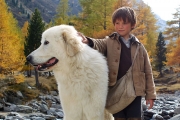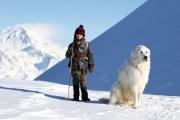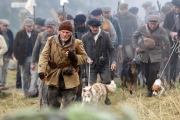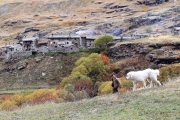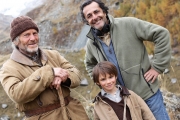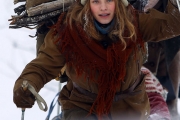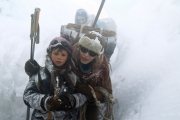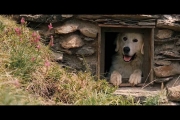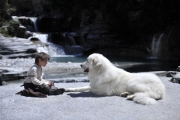![]() Presentation by and discussion with screenwriters Juliette Sales & Fabien Suarez
Presentation by and discussion with screenwriters Juliette Sales & Fabien Suarez
Based on the beloved children’s book and TV series Belle and Sebastian, the film introduces resourceful young Sebastian and the mountain sheepdog he tames and names Belle. The time is World War II, the place, the snowy Alps of occupied France where courageous villagers help Jewish refugees to reach the Switzerland border.
Cast & Crew
Director • Nicolas Vanier
Screenwriters • Nicolas Vanier, Fabien Suarez, Juliette Sales
based on the book and serie by Cécile Aubry
Producers • Clément Miserez, Matthieu Warter, Frédéric Brillon, Gilles Legrand
Starring :
Félix Bossuet, Tchéky Karyo, Margaux Chatelier, Dimitri Storoge, Medhi El Glaoui, Andreas Pietschmann, Urbain Cancelie…
Choose a picture to see the filmography (source : IMDB)
![]()
How was this new adaptation of Belle and Sebastian born?
As opposed to my other directorial projects, I was originally not involved in the project of Belle and Sebastian. The idea first came from our producer, Clément Miserez, my co-writers Fabien Suarez and Juliette Sales, and other people from Gaumont. When they were searching for a director, they happened to pick me as their top choice. The timing was perfect for me as I had just pushed back the project I was working on due to financial issues.
What is your memory of the television program?
As a child, I was completely addicted to it! I have to say I was already passionate about animals, nature and mountains and that the show impacted me deeply. It is not a trivial interest since even as an adult I had dedicated myself to dogs and nature. As such, when I was offered the project, I was almost intimidated by my memories: for me, it was not a banal TV show, but a lengthy collection of episodes, each more extraordinary than the other. It was a huge challenge, which did not displease me though it was a little distressing. Belle and Sebastian had awoken in me such strong emotions that I felt a strong duty to succeed. I had to create a movie for cinema, inevitably different from the series, while staying truthful to the fundamental components of the story, its characters and its universe.
How did you approach the adaptation?
From the very first meeting with Gaumont, I explained I was only accepting the job under certain conditions. First, we had to find a child who was exceptionally determined look and personality. Then, I insisted on shooting over three seasons. Finally, I had a wish to set the movie during World War II. It was in part an aesthetic preference since I did not want to shoot the mountain as it has become: I wanted to show a mountainous landscape of cottages and villages made of flagstone, whose colors and materials recall the leather, hemp and wood of the objects of that time. It is this aesthetic decision that led the writing process and allowed me to reconnect with an essential component of the series: adventure, journeys and the notion of passage. The War and the Jews’ flight toward Switzerland were perfect to explore these elements.
How did you work alongside your two co-writers?
It was a beautiful encounter, both professionally and personally. There was no guarantee it would be this way because I have already worked alongside greatly accomplished screenwriters and been hampered by our differing rhythms. Here, a real chemistry instantly formed between us, which allowed us to move forward very quickly and stay on the lookout without having to allocate responsibilities. We would mostly function through an exchange of ideas: sometimes, my co-writers had their own suggestions, which they would then communicate to me, and other times, we would come up with new possibilities by discussing together. It was a true peers’ work.
Did you try to remain truthful to the original characters?
I re-watched the series only once, at home, armed with a notebook and a pen, and whenever something struck me as important, whether it was a character or a place, I took note of it. This allowed me to keep what needed to be a part of the adaptation in mind. I chose to watch the episodes only once to then be able to distance myself from the original story. I just used the list of about thirty elements that were absolutely necessary.
What were the most challenging aspects of shooting?
Nothing seemed insurmountable, neither the mountain shoot nor the presence of the dog. The hardest part was to direct a 7½ years old child because so much of the movie relies on his ability to live this adventure from start to finish. The true big surprise was Félix’s –who plays Sebastian’s part – ability to understand precisely what I wanted, to never overact, to have pertinent ideas of his own and to always play with finesse.
How did you find Félix (who plays Sebastian)?
We received about 2400 applications for the part. The casting director had never seen such a craze: usually people want to read the screenplay first, but the popularity of the screenplay and having my name attached to the project were enough to reassure and enthuse the parents who sent photos of their children. 200 of them were preselected and, based on reels and readings, I chose a dozen to take to the Vercors where I have sleigh dogs. For a few days, I lived with these kids, I observed them and got to know them. Even if there were only three candidates left, I quickly knew which one I wanted and I pressed for Félix against all opposition, even if others may have seemed cuter at first. I loved his personality; he is a courageous and intelligent kid, but he can quickly clam up if you do not give him the time to get accustomed to you. There is something disconcerting and strange about him in which I detected a finesse that only he possessed.
Did you have trouble finding dogs to play Belle?
Based on certain criteria of weight and height, about a hundred dogs were identified. Andrew Simpson, who trained the animals for Le Dernier Trappeur and Loup, and in whom I have absolute trust, observed them. He chose 7 or 8 that he started training and ended up keeping three: Garfield, the star dog, and two others that served as body doubles. They each had a specific set of characteristics that allowed them to play calmer or more dynamic scenes. However, every time there is a close-up of a dog, it’s a close-up of Garfield.
What were some of your directorial choices?
If I had to sum them up in one word, I would say “restraint”. A calculated, thoughtful and assured restraint. Which is not synonymous with simplicity. I was wonderfully assisted by Luc Drion, a cameraman with such a precise grasp of frames, and Eric Guichard, a director of photography with a great understanding of lighting. Working with these two professionals was a stroke of luck: the three of us ended up together because of a common desire to build the movie by alternating between action phases and descriptive phases. As a result, when we were editing, we all tried to get in one shot what most people get in two.
Press Kit “Belle et Sebastien”
English ~ 8 pages ~ 1,8 Mo ~ pdf
Press Kit “Belle et Sebastien”
French ~ 31 pages ~ 9,2 Mo ~ pdf



